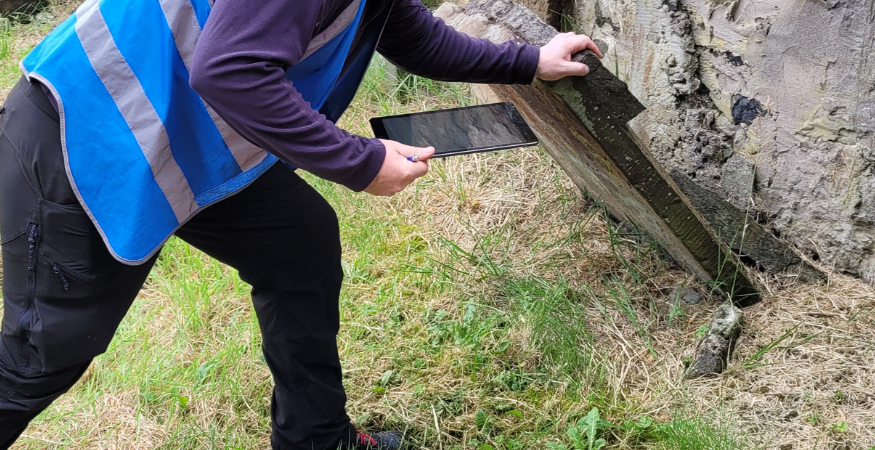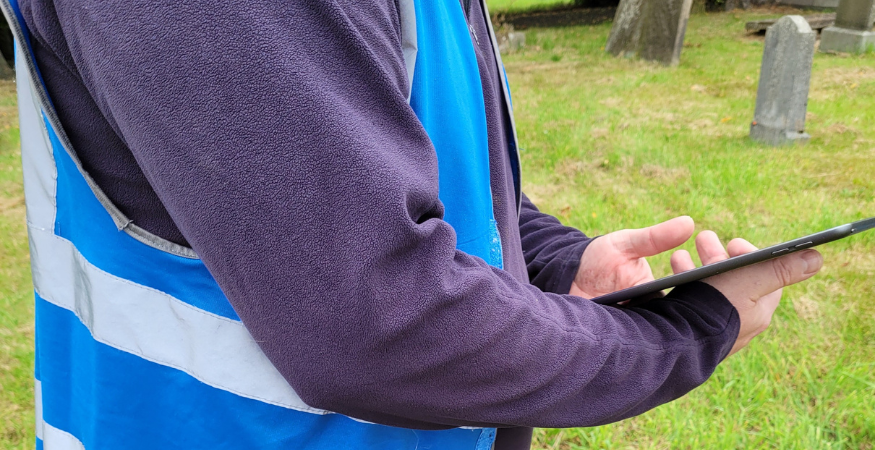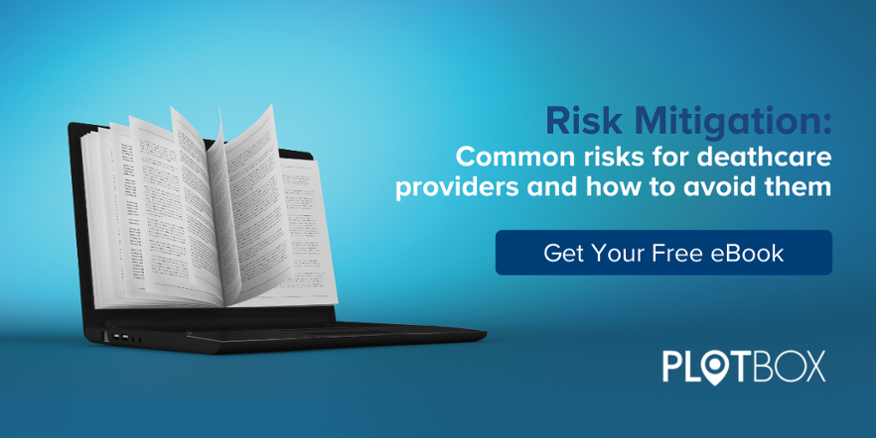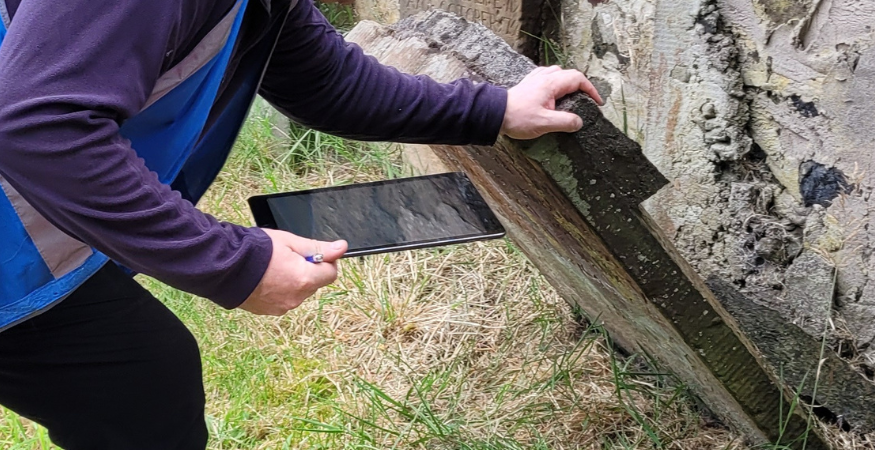| Read time: 7 mins
Why is cemetery risk assessment important?
Outside of any moral obligation, cemeteries - as both public spaces and as places of work - are subject to statutory and Health and Safety Executive (HSE) safety legislation, and as such, are responsible for the safety of those working in or visiting their sites.
In the UK, that responsibility lies with the burial authority in control of the cemetery, which may be a local authority, church or private company.[1]
Traditionally, issues around health and safety have been largely focused on grave digging, but increasingly, focus has turned to memorial safety, following a number of incidents where memorials toppled over causing injuries, some of which were fatal.
Many local authorities have implemented their own memorial management policies [2] as a way of helping to manage the risks associated with potentially unsafe memorials - informed in large part by, but not limited to:
the British Standard BS8415, guidance from the British Register of Accredited Memorial Masons (BRAMM) blue book, the National Association of Memorial Masons (NAMM) code of working practice, and guidance from the ICCM.
As memorial inspections become more common practice, and with good practice pointing to the importance of risk assessment (along with enforcement and training), it's important to have the right processes in place to support that.
That’s where cemetery software can help.
Risk assessment as part of a risk management process
“Risk assessment has a central role to play in the inspection and making safe process.” ICCM Management of Memorials 2019
Before we get to the ‘how’ let’s quickly provide some context. Risk management as a process can be broken down in a number of ways, but borrowing a little from organizational risk management, we might consider a typical process as:
Identify, Assess, Prioritize, Treat, Monitor and Report.
Now, let’s look at that in respect of the steps needed to manage risk as defined by the HSE:
Identify Hazards, Assess the risks, Control the risks, Record your findings, Review the controls.
Drilling a little further down into that guidance [3] on risk assessment in practice, that will involve recording all information relating to:
Who might be harmed and how;
what you're doing to control the risks;
what further action you need to take to control them;
who needs to carry out the action;
when the action is needed by;
Now, we can start to get a picture of where risk assessment fits into the broader picture of safety and managing risk.
With all of that in mind, let’s look at the use of technology in risk mitigation and how cemetery software such as PlotBox can help support good practice, implement measured procedures, and put processes into practice to minimize risk:

#0.5 It makes it easier
Before we start our list ‘proper’, a quick opening salvo...cemetery management software can make carrying out safety inspections easier by providing a single point of entry - a 'single source of truth’ - for all of your information.
Everything together into one place, vs reams of paperwork and disjointed systems saves time and effort, helps planning, improves communication and reduces the risk of error.
Linked to cemetery plot records, PlotBox’s Risk Assessment module allows you to record memorial safety inspections, view inspection histories and outcomes, generate inspection schedules, pull reports, create action plans and more.
In short, it helps provide a complete picture of your risk assessments.
Of course, easier isn’t always better, so let’s look at some real world benefits to your processes:
#1. It helps keep you compliant
Accessibility of data is all-important.
How easy is it for you to run risk assessment reports?
Remaining compliant means knowing exactly the status of what you have and where you have it. Without easy access to that information, you run the risk of plots, memorials, monuments, or other features remaining in a potentially unsafe condition, and without the appropriate measures being carried out in good time.
Running a status report will allow you to see when plots are due their next risk assessment. Pull data across a time period and view all risk assessments, along with a range of useful information, including the result, memorial type and condition; then generate and export custom reports, filtering data using configurable columns.
Photographs of work carried out before and after uploaded highlight measures taken and also allows the work of the Memorial Mason to be inspected.
Which means that…knowing well in advance the status of all of your plots and memorials, you can take necessary safety measures and inspect work carried out to ensure you remain compliant.
#2. It supports a risk-based approach
Guidance outlined in the Managing the safety of Burial Ground Memorials document developed by a sub group of the Burial and Cemeteries Advisory Group, sets out a risk-based approach based on good practice to help operators to "develop a proportionate approach to managing risks associated with memorials".
Within the guidance it’s suggested that a risk assessment “provides for a focus on those risks with the potential to cause real harm” and points to the Five step approach outlined by the HSE, touched on above:
Step 1: Identify the hazard;
Step 2: Identify who might be harmed and how;
Step 3: Evaluate the risk of a memorial falling and harming someone, and decide on the precautions needed to control this risk;
Step 4: Record the significant findings of the risk assessment and take steps to implement the precautions needed;
Step 5: Review the risk assessment periodically and update as necessary.
With the ability to record the outcomes of safety inspections, you can identify the level of and reason for risk, along with what action is required and when the next assessment is required.
Risk assessment history linked to plots - whether open, completed or requiring action, lets you review and return to assessments as required.
When undertaking a proportionate, rolling programme of risk assessment, this interrogable information source will help with proactive planning - ensuring that you’re carrying out work in respect to the level of risk.
And when looking at zonal assessments, this data, in helping to create a picture and itinerary of memorials, can help in ranking from highest to lowest risk, allowing you to constantly reduce your exposure.
Which means that…you have all of the visibility of data you need to manage and plan your proportionate rolling programmes effectively, and prioritize appropriately.

#3. It helps improve operational efficiency and communication
When talking about operational efficiencies, it’s usually not long before the subject of workflows comes up. In simple terms, a workflow is a sequence of tasks carried out to get a piece of work done - you may, for example, have a workflow in place for carrying out your risk assessments.
Getting them right can help to increase efficiencies, improve communication and reduce the risk of errors.
Automating workflows - which cemetery management software can help you to do - will help to refine these processes even further, for even better risk management.
You can learn more about workflows in our Insiders Guide to Risk Assessments.
To provide operational efficiencies and communication within a practical context, let’s consider the advantages of giving your grounds crew the ability to view and pinpoint locations of plots on digital maps, and the mobility to record risk assessment information when onsite.
Using the PlotBox ipad app, they can do just that.
Without the need to go back and forth to the office, plots can be searched for, found and accurate information and images captured 'in the moment' that become instantly available.
In terms of risk assessments, clear communication, not only between team members, is important, but also with other stakeholders, and families.
Having an online portal for Masons to request permits and receive progress updates, for example, will help to streamline processes, reducing the need for time-draining phone calls and paperwork - facilitating ease of communication, resolving issues quicker, and, as those legally responsible for the work they carry out, helping to ensure compliance around policy and regulations.
Deed holders, as memorial owners, also hold their own responsibilities in terms of their maintenance, so it’s important to have all of the information you need to communicate with them in a timely way.
This may be a challenge with older records relating to older memorials, however having easily accessible deed holder information linked directly to plots, along with risk assessment history can make this process much easier.
Which means that…your processes are streamlined and more efficient, keeping you, your teams and your stakeholders connected.
Refs
[1] Memorandum by the Health and Safety Executive (CEM 102)
[2] Memorial safety inspection - Belfast City Council
[3] Managing risks and risk assessments at work - HSE
Like to know more on risk mitigation? Download our eBook today:

